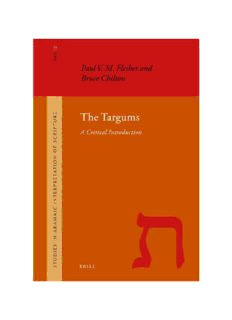Table Of ContentThe Targums
Studies in the Aramaic
Interpretation of Scripture
Managing Editor
Paul V.M. Flesher
University of Wyoming
Editorial Board
Bruce Chilton, Bard College
Willem Smelik, University College, London
Moshe Bernstein, Yeshiva University
Edward M. Cook, Catholic University of America
Luis Díez Merino, University of Barcelona
VOLUME 12
The Targums
A Critical Introduction
By
Paul V.M. Flesher
Bruce Chilton
LEIDEN • BOSTON
2011
This book is printed on acid-free paper
Library of Congress Cataloging-in-Publication Data
Flesher, Paul Virgil McCracken.
The Targums : a critical introduction / Paul V. M. Flesher and Bruce D. Chilton.
575 p. cm.
Includes bibliographical references and index.
ISBN 978-1-60258-382-5 (pbk. : alk. paper)
1. Bible. O.T. Aramaic--Versions. 2. Bible. O.T. Aramaic--Criticism, interpretation, etc.
3. Bible. O.T.--Criticism, interpretation, etc., Jewish. 4. Bible. N.T.--Relation to the Old
Testament. 5. Rabbinical literature--History and criticism. 6. Judaism--History--Post-exilic
period, 586 B.C.-210 A.D. 7. Church history--Primitive and early church, ca. 30-600.
I. Chilton, Bruce. II. Title.
BS709.4.F54 2011
221.4’2--dc22
2010052534
ISSN 1570-1336
ISBN 978 90 04 21769 0
Copyright 2011 by Baylor University Press
Waco, Texas 76798-7363
All rights reserved. No part of this publication may be reproduced, translated, stored in
a retrieval system, or transmitted in any form or by any means, electronic, mechanical,
photocopying, recording or otherwise, without prior written permission from the publisher.
Authorization to photocopy items for internal or personal use is granted by Koninklijke Brill NV
provided that the appropriate fees are paid directly to The Copyright Clearance Center,
222 Rosewood Drive, Suite 910, Danvers, MA 01923, USA.
Fees are subject to change.
For
Jacob Neusner,
whose intellectual energy and insight has shaped
the study of ancient Judaism in the modern world,
and
Martin McNamara,
who helped bring the study of the Targumim
into the modern world and establish a foundation for their
understanding.
TABLE OF CONTENTS
Preface ix
Acknowledgments xiii
List of Abbreviations xv
Section I: Getting Started
1 Introduction 3
2 Defining Targum 19
3 The Seven Rules of Targum 39
4 Rabbinic Literature 55
Section II: The Pentateuchal Targums
5 Pentateuchal Targums: The Basics 71
6 Sources of the Palestinian Targums 91
7 Targum Onqelos and the Targums of Israel 109
8 The Pentateuchal Targums in Rabbinic Literature 131
9 Dating the Targums of Israel 151
Section III: The Targums of the Prophets and the Writings
10 Targum Jonathan of the Prophets: Its Development as
Revealed by the Targum of Isaiah 169
11 Targum Jonathan: Former and Latter Prophets 199
12 Targums to the Writings 229
Section IV: The Targums in Late-Antique Judaism
13 Aramaic in Judaism 267
14 Targums and Translation in the History of Rabbinic
Literature 285
viii TABLE OF CONTENTS
15 Targum as Scripture and Hidden Interpretation 325
16 Ancient Scripture Translations 339
Section V: The Targums and Early Christianity
17 Comparing the Targums and the New Testament 385
18 The Aramaic Retroversion of Jesus Sayings 409
19 The Fourth Gospel and Targumic Memra 423
Section VI: Conclusions and Prospects
20 Genesis 22 in the Targumim and in Early Jewish
and Christian Interpretation 439
21 Targums in the Rabbinic World and Beyond 475
Appendix A: The Parallel Expansions of Genesis 28–50 495
Appendix B: A Guide to Babylonian Pointing 499
Glossary 501
Bibliography 511
Index 541
PREFACE
The Jewish Targums constitute the largest body of sustained Scripture
translation and interpretation from the ancient world. Unfortunately, they
are also the least well known. In comparison to the (mostly fragmentary)
works of biblical exegesis from the Dead Sea Scrolls, the Targums lack
the enthusiasm of recent discovery and decipherment. In comparison to
the Septuagint, scholars have thought they lacked dedication to exacting
translation. And, over the two millennia of rabbinic Judaism, they have
received ambiguous and inconsistent treatment. While Babylonian Juda-
ism ultimately received Targum Onqelos to the Pentateuch and Targum
Jonathan to the Prophets as authoritative, the Palestinian works of hal-
akhah treated Targums as suspect and untrustworthy during their early
centuries. The large number of Pentateuchal Targums attributed to Pal-
estine, however, suggests they were once quite popular. Within a few cen-
turies, though, they were forgotten. When asked for further information,
one learned medieval rabbi admitted to knowing nothing about them.
While some Targums were preserved and published by Jews, a surpris-
ingly large amount of our present knowledge of them comes from Jewish
waste heaps (genizahs) and from recently discovered “lost” manuscripts
in Christian libraries. In comparison to the Babylonian and Palestinian
Talmuds, and even to the midrashim, the learned circles of Judaism
treated Targums as decidedly secondary.
That does not mean that the Targums were ignored. Targums
belonged more to the liturgy than the academy. The public performance
of Aramaic translation formed part of the bet knesset, the synagogue,
rather than the bet midrash, the study house. As such, they provide a
window into the beliefs and theology of ordinary Jews rather than the
highly educated. And we should keep in mind that educated people who
were skilled in reading and writing were much more rare within the
Description:The value and significance of the targums—translations of the Hebrew Bible into Aramaic, the language of Palestinian Jews for centuries following the Babylonian Exile—lie in their approach to translation: within a typically literal rendering of a text, they incorporate extensive exegetical mater

